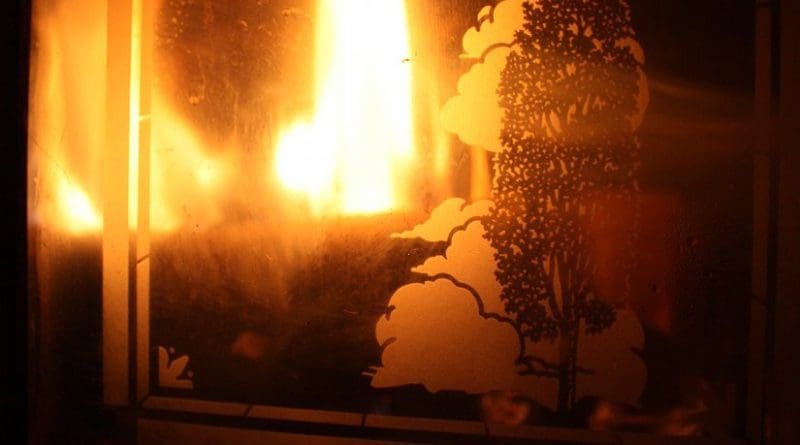Illegal Aliens Causing Wildfires In Arizona – OpEd
By Jim Kouri
In yet another government report sure to be ignored by elected leaders and the majority of news organizations, illegal aliens are suspected of having a negative impact on the environment by their igniting wildland fires on the U.S. side of the border.
Recently, Senator John McCain accused some illegal aliens of being pyromaniacs and he was chastised by many Democrats, illegal alien advocates and members of the elite media.
Wildland fires as with other disasters can be either natural and man-made. Human-caused wildland fires are of particular concern in Arizona — especially within 100 miles of the U.S.-Mexico border — because this is a primary area of entry for illegal border crossers. The Government Accountability Office has in the past reported that illegal border crossers have been suspected of igniting wildland fires.
Over half of the land in the Arizona border region is managed by the federal government — primarily by the Department of Agriculture’s Forest Service and four agencies within the Department of the Interior.
These agencies collaborate with state, tribal, and local agencies to respond to wildland fires. Congress asked the GAO to examine for the region, the number, cause, size, and location of wildland fires from 2006 through 2010; the economic and environmental effects of human-caused wildland fires burning 10 or more acres; the extent to which illegal border crossers were the ignition source of wildland fires on federal lands; and the ways in which the presence of illegal border crossers has affected fire suppression activities.
GAO analysts reviewed interagency policies and procedures; analyzed wildland fire data; and interviewed federal, tribal, state, and local officials, as well as private citizens.
From 2006 through 2010, at least 2,467 wildland fires occurred in the Arizona border region. Of this number, 2,126, or about 86 percent, were caused by human activity.
The majority of these fires –1 ,364 — burned less than 1 acre each. About 63 percent or 1,553 of the 2,467 fires were ignited on federally managed land or tribal land. Human-caused wildland fires that burned 10 or more acres had a number of economic and environmental impacts on the Arizona border region, but these impacts cannot be fully quantified because comprehensive data are not available.
Specifically, these fires resulted in over $35 million in fire suppression costs by federal and state agencies, destruction of property, impacts on ranching operations, and impacts on tourism. Similarly, these fires had several environmental impacts, such as the expansion of nonnative plant species, degraded endangered species habitat, and soil erosion.
However, the full economic and environmental impacts cannot be determined because complete information about these impacts is not available. The total number of fires ignited by illegal border crossers on federal lands in the Arizona border region is not fully known, in part because federal land management agencies have not conducted investigations of all human-caused wildland fires that occurred on these lands, as called for by agency policy, and the agencies do not have a strategy for selecting fires they do investigate.
Of the 422 human-caused wildland fires that occurred on Forest Service, Interior, or tribal lands and burned at least 1 acre from 2006 through 2010, only 77 were investigated. According to land management agency officials, the lack of trained fire investigators was the primary reason for the limited number of investigations. Of the investigations conducted, 30 identified illegal border crossers as a suspected source of ignition.
Agency policy notes that identifying trends in fire causes is critical to the success of fire prevention programs, but without better data on the specific ignition sources of human-caused wildland fires in the region, the agencies are hampered in their ability to target their efforts to prevent future wildland fires.
The presence of illegal border crossers has complicated fire suppression activities in the Arizona border region. According to agency officials, the presence of illegal border crossers has increased concerns about firefighter safety and, in some instances, has required firefighters to change or limit the tactics they use in suppressing fires. For example, the presence of illegal border crossers has limited firefighting activities at night and complicated the use of aerial firefighting methods. In other words, illegal aliens are considered a danger to those responding to a fire emergency.
The agencies have taken some steps to mitigate the risks to firefighters by, for example, using law enforcement to provide security. However, none of the agencies have developed or implemented a risk-based approach for addressing these challenges. Consequently, law enforcement resources are routinely dispatched to all fires regardless of the risk, which may prevent the agencies from using their limited resources most efficiently.
While the Forest Service has developed a formal policy for addressing the risks to firefighters in the region, the other agencies have neither formally adopted this policy nor developed their own. GAO recommended in its report to Congress that among other things, the agencies develop strategies for selecting fires to investigate and establish a risk-based approach for utilizing law enforcement resources. In their comments on a draft of this report, the Forest Service and the Department of the Interior generally agreed with these recommendations.

